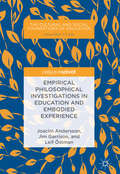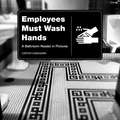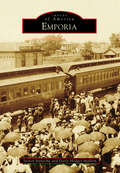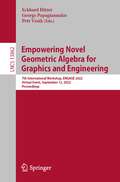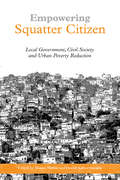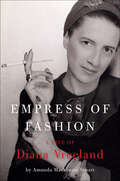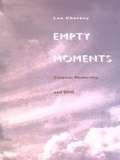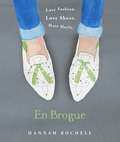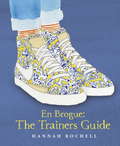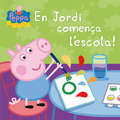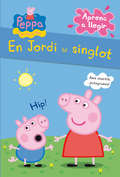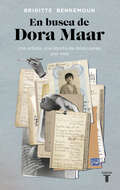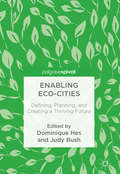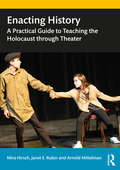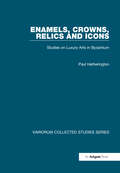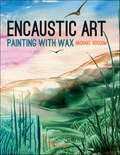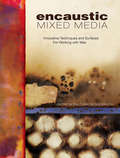- Table View
- List View
Empires of Vision: A Reader
by Martin Jay Sumathi RamaswamyEmpires of Vision brings together pieces by some of the most influential scholars working at the intersection of visual culture studies and the history of European imperialism. The essays and excerpts focus on the paintings, maps, geographical surveys, postcards, photographs, and other media that comprise the visual milieu of colonization, struggles for decolonization, and the lingering effects of empire. Taken together, they demonstrate that an appreciation of the role of visual experience is necessary for understanding the functioning of hegemonic imperial power and the ways that the colonized subjects spoke, and looked, back at their imperial rulers. Empires of Vision also makes a vital point about the complexity of image culture in the modern world: We must comprehend how regimes of visuality emerged globally, not only in the metropole but also in relation to the putative margins of a world that increasingly came to question the very distinction between center and periphery.Contributors. Jordanna Bailkin, Roger Benjamin, Daniela Bleichmar, Zeynep Çelik, David Ciarlo, Natasha Eaton, Simon Gikandi, Serge Gruzinski, James L. Hevia, Martin Jay, Brian Larkin, Olu Oguibe, Ricardo Padrón, Christopher Pinney, Sumathi Ramaswamy, Benjamin Schmidt, Terry Smith, Robert Stam, Eric A. Stein, Nicholas Thomas, Krista A. Thompson
Empirical Philosophical Investigations in Education and Embodied Experience (The\cultural And Social Foundations Of Education Ser.)
by Jim Garrison Joacim Andersson Leif ÖstmanDrawing on John Dewey and the later Ludwig Wittgenstein, this book employs philosophy as a conceptual resource to develop new methodological and analytical tools for conducting in situ empirical investigations. Chapter one explores the philosophies of Wittgenstein and Dewey. Chapter two exposits Deweyan ideas of embodiment, the primacy of the aesthetic encounter, and aesthetically expressive meaning underdeveloped in Wittgenstein. Chapter three introduces the method of practical epistemological analysis (PEA) and a model of situated epistemic relations (SER) to investigate the learning of body techniques in dinghy sailing. The concluding chapter introduces a model of situated artistic relations (SAR) to investigate the learning of artistic techniques of self-expression in the Swedish sloyd classroom.
Employees Must Wash Hands: A Bathroom Reader in Pictures
by Carter HasegawaFinally, photographic proof of what’s behind the public bathroom door.Must Wash Hands, a collection of 120 artistic photographs, offers readers a peek into the private space of the public bathroom-that unspoken and indecent yet communal and necessary space that we enter and exit every day without a second glance.With camera in hand, Carter Hasegawa travels the public bathrooms of Boston, New York, Seattle, Las Vegas, Honolulu, Indianapolis, and other American cities, snapping photos down urinals and documenting graffitied walls and wet, toilet paper-plastered floors. Photos are arranged "chronologically” as a virtual public restroom walkthrough for the reader, and they highlight unsavory and savory bathroom elements you otherwise may not have noticed-ice cubes down a urinal, unconventional "Employees Must Wash Hands” signs, interesting tile details, or a jar of baby food on the floor. These wry but intimate photos are interspersed with popular bathroom trivia, illegally overheard bathroom conversations, half-serious comments on "proper” bathroom etiquette, and seriously real anecdotes.For fans of offbeat photography and humor books such as Awkward Family Photos, People of Walmart, and Regretsy, Must Wash Hands transforms the crude and disgusting into something more compelling and beautiful, prompting the viewer to pause, admire, laugh, and connect.
Emporia (Images of America)
by Steven F. Hanschu Darla Hodges MalleinEstablished in February 1857, Emporia's founding fathers named their new business venture Emporia after a flourishing market center in Ancient Carthage. Located in the east-central part of Kansas, Emporia is known as the "Front Porch to the Flint Hills." William Allen White, publisher and editor of the Emporia Gazette, brought national attention to Emporia in the early 1900s. Known for his fiery political essays, White became an advisor to many US presidents, five of whom visited his home, Red Rocks. Emporia is home to Emporia State University, the state's first normal school, founded in 1863. Located on the university campus are the National Teachers Hall of Fame and the Memorial to Fallen Educators, honoring those who lost their lives teaching and working in America's schools. Honoring fallen heroes is a long-standing tradition in Emporia, as it is also the founding city of Veterans Day.
Emporia Rose Appliqué Quilts: New Projects, Historical Vignettes, Classic Designs
by Barbara Brackman Karla Menaugh“Inspired by the still astonishing quilts made from the 1920s through the 1940s in Emporia, Kansas . . . world-renowned for their design and workmanship.” —Publishers Weekly Between 1925 and 1945, women from Emporia, Kansas, created some of the twentieth-century’s most memorable appliqué quilts. Their designs were the modern quilts of their day. They earned both international renown and permanent places in museum collections. Now bestselling quilt historian Barbara Brackman and writer Karla Menaugh bring you seven spectacular new quilts based on those ground-breaking originals, plus the fascinating history of the women and times that produced the Emporia style. Seven projects include a nine-block appliqué sampler, featuring flowers, swags, and festoons.Timeless designs work with any appliqué technique. Mix and match elements into your own new classics.
Empowering Novel Geometric Algebra for Graphics and Engineering: 7th International Workshop, ENGAGE 2022, Virtual Event, September 12, 2022, Proceedings (Lecture Notes in Computer Science #13862)
by George Papagiannakis Eckhard Hitzer Petr VasikThis book constitutes the proceedings of the Workshop Empowering Novel Geometric Algebra for Graphics and Engineering, ENGAGE 2022, held in conjunction with Computer Graphics International conference, CGI 2022, which took place virtually, in September 2022. The 10 full papers included in this volume were carefully reviewed and selected from 12 submissions. The workshop focused specifically on important aspects of geometric algebra including algebraic foundations, digitized transformations, orientation, conic fitting, protein modelling, digital twinning, and multidimensional signal processing.
Empowering Squatter Citizen: Local Government, Civil Society and Urban Poverty Reduction
by David Satterthwaite Diana MitlinWith the rapid growth in urban poverty in Africa, Asia and Latin America, most cities now have 30 to 60 per cent of their population living in shanty towns. The civil and political rights of these people are either ignored or constantly contravened. They face multiple deprivations, including hunger, long hours working for inadequate incomes; illness, injury and premature deaths that arise from dangerous living conditions and inadequate water supplies, sanitation and healthcare. Many face the constant threat of eviction and other forms of violence. None of these problems can be addressed without local changes, and Empowering Squatter Citizen contends that urban poverty is underpinned by the failure of national governments and aid agencies to support local processes. It makes the case for redirecting support to local organizations, whether governmental, non-governmental or grassroots. . The book includes case studies of innovative government organizations (in Thailand, Mexico, Philippines and Nicaragua) and community-driven processes (in India, South Africa, Pakistan and Brazil), which illustrate more effective approaches to urban poverty reduction. Such approaches include strengthening the organizations of the poor and homeless so that they are accountable to their members, are able to develop their own solutions and have more capacity to negotiate with the institutions that are meant to deliver infrastructure, services, credit and land for housing. Such support for local processes is crucial for meeting the Millennium Development Goals in urban areas.
Empress of Fashion: A Life of Diana Vreeland
by Amanda Mackenzie Stuart“The first comprehensive bio of legendary magazine editor Diana Vreeland is a can’t-put-down read.” —PeopleFrom her career at the helms of Harper’s Bazaar and Vogue to her reign as consultant to the Costume Institute at the Metropolitan Museum of Art, Vreeland had an enormous impact on the fashion world and left a legacy so enduring that must-have style guides still quote her often-wild and always-relevant fashion pronouncements.With access to Vreeland’s personal material and photographs, Amanda Mackenzie Stuart has written the definitive behind-the-scenes look at the woman and her world—a jet-setting social scene that included Coco Chanel, Elsa Schiaparelli, Yves Saint Laurent, Hubert de Givenchy, Oscar de la Renta, Lauren Bacall, Penelope Tree, Lauren Hutton, Andy Warhol, Mick and Bianca Jagger, and the Kennedys. Filled with gorgeous color photographs of her work, Empress of Fashion is an intimate, surprising look at “the imperious, mesmerizing virtuoso who wandered onto the fashion stage and stole the show.” (New York Daily News).“Dazzlingly comprehensive, perceptive and many-sided.” —The New York Times Book Review“Stands out for its un-gushy, arm’s-length observation of a woman who used any means possible—including outrageous lies—to create the mise en scène for her life.” —The Wall Street Journal“A nuanced portrait of a strange and tantalizing woman.” —Daily Beast
Empresses of Seventh Avenue: World War II, New York City, and the Birth of American Fashion
by Nancy MacDonellA NEW YORK TIMES MOST ANTICIPATED • In the tradition of The Barbizon and The Girls of Atomic City, fashion historian and journalist Nancy MacDonell chronicles the untold story of how the Nazi invasion of France gave rise to the American fashion industry.Calvin Klein. Ralph Lauren. Donna Karan. Halston. Marc Jacobs. Tom Ford. Michael Kors. Tory Burch. Today, American designers are some of the biggest names in fashion, yet before World War II, they almost always worked anonymously. The industry, then centered on Seventh Avenue in Manhattan, had always looked overseas for "inspiration"—a polite phrase for what was often blatant copying—because style, as all the world knew, came from Paris.But when the Nazis invaded France in 1940, the capital of fashion was cut off from the rest of the world. The story of the chaos and tragedy that followed has been told many times—but how it directly affected American fashion is largely unknown.Defying the naysayers, New York-based designers, retailers, editors, and photographers met the moment, turning out clothes that were perfectly suited to the American way of life: sophisticated, modern, comfortable, and affordable. By the end of the war, "the American Look" had been firmly established as a fresh, easy elegance that combined function with style. But none of it would have happened without the influence and ingenuity of a small group of women who have largely been lost to history.Empresses of Seventh Avenue will tell the story of how these extraordinary women put American fashion on the world stage and created the template for modern style—and how the nearly $500 billion American fashion industry, the largest in the world, could not have accrued its power and wealth without their farsightedness and determination.
Empty Moments: Cinema, Modernity, and Drift
by Leo CharneyIn Empty Moments, Leo Charney describes the defining quality of modernity as "drift"--the experience of being unable to locate a stable sense of the present. Through an exploration of artistic, philosophical, and scientific interrogations of the experience of time, Charney presents cinema as the emblem of modern culture's preoccupation with the reproduction of the present. Empty Moments creates a catalytic dialogue among those who, at the time of the invention of film, attempted to define the experience of the fleeting present. Interspersing philosophical discussions with stylistically innovative prose, Charney mingles Proust's conception of time/memory with Cubism's attempt to interpret time through perspective and Surrealism's exploration of subliminal representations of the present. Other topics include Husserl's insistence that the present can only be fantasy or fabrication and the focus on impossibility, imperfection, and loss in Kelvin's laws of thermodynamics. Ultimately, Charney's work hints at parallels among such examples, the advent and popularity of cinema, and early film theory. A book with a structural modernity of its own, Empty Moments will appeal to those interested in cinema and its history, as well as to other historians, philosophers, literary, and cultural scholars of modernity.
Empty Spaces
by Jordan AbelA hypnotic and mystifying exploration of land and legacy, investigating what it means to be an intergenerational, Indigenous survivor of Residential Schools Jordan Abel&’s new work grows out of the groundbreaking visual expression in his recently published NISHGA, a book that combined nonfiction with photography, concrete poetry, and literary inquiry. Whereas NISHGA integrated descriptions of the landscape from James Fenimore Cooper&’s settler classic The Last of the Mohicans into visual pieces, Empty Spaces reinscribes those words on the page itself, and in doing so subjects them to bold rewritings. Reimagining the nineteenth-century text from the contemporary perspective of an urban Nisga&’a person whose relationship to land and traditional knowledge and spiritual traditions was severed by colonial violence, Abel attempts to answer his research question of what it means to be Indigenous without access to familial territory. Engaging the land through fiction and metaphor, Abel creates an eerie, looping, and atmospheric rendering of place that evolves despite the violent and reckless histories of North America. The result is a bold and profound new vision of history that decenters human perception and forgoes Westernized ways of seeing. Rather than turning to characters and dialogue to explore truth, Abel invites us to instead understand that the land knows everything that can and will happen, even as the world lurches toward uncertainty.
En Brogue: A Girl's Guide to Flat Shoes and How to Wear them with Style.
by Hannah Rochell'If there's one fashion book you should be buying this season it's this one.' Times FashionDo you know the difference between a derby and an Oxford? Tassel loafers or penny loafers? Do you know why brogues have holes in them? From brogues to boots, pumps to penny loafers, slippers to sandals, En Brogue honours forty styles of shoes with beautiful hand drawn illustrations, quirky photographs and fascinating facts about the history of our favourite flats. En Brogue dips a (well-clad) toe into the world of fashion, and will get everyone sharing their love of comfy, chic and stylish flat shoes!This book will make the perfect gift for all your friends.www.enbrogue.com
En Brogue: Love Fashion. Love Shoes. Hate Heels
by Hannah RochellDo you know the difference between a derby and an Oxford? Tassel loafers or penny loafers? Do you know why brogues have holes in them? From brogues to boots, pumps to penny loafers, slippers to sandals, En Brogue honours forty styles of shoes with beautiful hand drawn illustrations, quirky photographs and fascinating facts about the history of our favourite flats. En Brogue dips a (well-clad) toe into the world of fashion, and will get everyone sharing their love of comfy, chic and stylish flat shoes! This book will make the perfect gift for all your friends and you'll be hoping to find a copy in your own Christmas stocking. www.enbrogue.com
En Brogue: The Trainers Guide
by Hannah RochellTrainers are no longer just reserved for the gym. From the office to the catwalk (and even hidden under wedding dresses), trainers have become a must-have fashion staple for women of all ages. Who better to chart the history of this most comfortable form of footwear than flat shoe expert and blogger Hannah Rochell of enbrogue.com?Here Hannah picks over 40 styles of trainers - including your favourite iconic brands and some exciting collaborations - and shares her knowledge and style tips on how you can wear them and look great. From Reebok Classics to designer Dior Fusion sneakers, and from limited edition Liberty print Nike Air Max to the ubiquitous Converse All Star, flat shoes have never been more comfortable... and trainers have never been more in style.
En Jordi comença l'escola! (La Porqueta Pepa. Primeres lectures)
by Varios AutoresAprenem a llegir amb les aventures de la Pepa, la porqueta més famosa. Llegeix aquesta història i descobriràs què li va passar a la Pepa el primer dia que en Jordi va anar a escola amb ella. Avui és el primer dia que en Jordi va a l'escola, i a la Pepa no li fa gaire gràcia. Però quan vegi com es diverteixen els altres nens amb el seu germanet, potser canviarà d'idea... Els llibres de la col·lecció «Primeres lectures» de la Porqueta Pepa estan pensats per nens que tot just comencen a llegir. Els textos contenen vocabulari senzill, els interior són molt visuals i, a més a més, conten les divertides aventures del personatge més estimat pels nens. Tot això garanteix que els petits lectors se sentin motivats per la lectura, s'entretinguin i s'estimuli la seva imaginació.
En Jordi té singlot (La Porqueta Pepa)
by Varios AutoresLa Pepa i en Jordi tenen tantes ganes de sortir a jugar al jardí que esmorzen massa de pressa i a en Jordi li agafa singlot. Descobreix el remei de la Pepa per fer-l'hi passar.
En busca de Dora Maar: Una artista, una libreta de direcciones, una vida
by Brigitte BenkemounLa apasionante vida de una artista de vanguardia contada a partir del descubrimiento fortuito de una libreta de direcciones. En busca de un reemplazo para la agenda Hermès que ha perdido su marido, Brigitte Benkemoun compra una antigua en eBay. Casi idéntica a la original, con «el mismo cuero liso, pero más rojo, más suave, y con una pátina brillante», esconde en su interior una libreta de direcciones que data de 1951. Al hojearla, descubre con gran fascinación que los nombres que aparecen en sus veinte páginas (en la B, Breton, Braque y Balthus; en la C, Cocteau; en la E, Éluard...) son «los más grandes artistas de posguerra ordenados alfabéticamente», que pasan a ser el hilo conductor de este libro. Benkemoun emprende entonces una búsqueda obsesiva y pronto averigua que la agenda perteneció a Dora Maar, la famosa Mujer que llora de Picasso y una artistabrillante por derecho propio. La autora se embarca en un viaje de descubrimiento de dos años para contar la historia de una mujer provocativa, apasionada y enigmática, y el papel que cada una de aquellas figuras desempeñó en su vida. El resultado es un retrato único y deslumbrante de la artista y su mundo a través de instantáneas, escenas de fiestas e icónicos cafés, y fragmentos impactantes de su poesía y de la poesía escrita sobre ella. La crítica ha dicho:«Una de las felices sorpresas del final de la temporada literaria».Livres Hebdo «Poderoso y basado en una profunda investigación. El entusiasmo de la autora por el tema es contagioso».The New York Times «Una narrativa sinuosa en la que los capítulos están unidos por encuentros casuales y asociaciones de ideas. La autora descubre material de archivo fascinante y crea una vibrante galería de retratos».Times Literary Supplement «Este apasionante estudio de París y su vanguardia artística debería ser lectura obligada para los amantes del arte moderno y surrealista».Publishers Weekly «Historia del arte combinada con una obra detectivesca. ¿Puede haber algo más apasionante?».ARTnews «Deliciosamente mordaz, atractivo, fascinante, inteligente».LitHub «En la versión de Benkemoun de la historia del arte, visualizamos las habitaciones donde los pintores vivieron sus aventuras, los colores de sus uñas y el almuerzo especial que se servía en el café el día que Picasso cenaba con su amante y conoció a la siguiente. Un alegre recordatorio de quiénes fueron las personas detrás de ciertos nombres hoy icónicos».Hyperallergic «Es maravilloso el modo en que el encuentro casual con un objeto aparentemente insignificante da lugar a un mundo de descubrimientos y emoción personales, una emoción que Benkemoun, en la mejor tradiciónsurrealista y biográfica, logra transmitir».Reading in Translation
Enabling Creative Chaos: The Organization Behind the Burning Man Event
by Katherine K. ChenThis book examines the Burning Man organization to show how we have the agency to mold organizational experiences more to our liking.
Enabling Eco-Cities
by Dominique Hes Judy BushCities are striving to become more resilient, adaptive and sustainable; this requires new ways of governing and developing the city. This book features chapters by researchers using regenerative development and transitions theories to envisage how Eco-Cities could be planned, designed and created, and concludes with practical tools and an outline of how this evolution could be facilitated. It examines two major questions: How can we use understandings of Eco-Cities to address the legacy of urban built form and existing practices which often make it difficult to create the systemic changes needed? And what are the elements of complex urban places and spaces that will enable the planning, creation and evolution of thriving cities?The book will appeal to planners, city makers, urban researchers, students and practitioners, including planners, designers, architects and sustainability managers, and all those seeking to envisage the steps along the path to thriving cities of the future.
Enabling Urban Alternatives: Crises, Contestation, and Cooperation
by Lee Pugalis Jens Kaae Fisker Letizia Chiappini Antonella BruzzeseThis book asks how thinking, governing, performing, and producing the urban differently can assist in enabling the creation of alternative urban futures. It is a timely response to the ongoing crises and pressing challenges that inhabitants of cities, towns, and villages worldwide are faced with in the midst of what has been widely dubbed as ‘an urban age’. Starting from the premise that current urban development patterns are unsustainable in every sense of the word, the book explores how alternative patterns can be pursued by the wide variety of actors – from governments and international institutions to slum-dwellers and social movements – involved in the on-going production of our shared urban condition. The challenges addressed include exclusion and segregation; persisting poverty and increasing inequality; urban sprawl and changing land use patterns; and the spatial frames of urban policy. As such the book appeals to urban scholars, policy makers, activists, and others concerned with shaping the future of our cities and of urban life in general. Additionally, it is of interest to students in urban planning, architecture and design, human geography, urban sociology, and related fields.
Enabling the City: Interdisciplinary and Transdisciplinary Encounters in Research and Practice
by Katrin Paadam Josefine Fokdal Olivia Bina Prue Chiles Liis OjamäeEnabling the City is a collaborative book that focuses on how interdisciplinary and transdisciplinary processes of knowledge production may contribute to urban transformation at a local level in the 21st century, striking a balance between enthusiastic support for such transformational potential and a cautious note regarding the persistent challenges to the ethos as well as the practice of inter and transdisciplinarity. The rich stories reflect different research and local practice cultures, exploring issues such as ageing, community, health and dementia, public space, energy, mobility cultures, heritage, housing, re-use, and renewal, as well as more universal questions about urban sustainability and climate change, and perhaps most importantly, education. Against this backdrop, aspirations for the 21st century are related to the international, national, and local agendas expressed in the Sustainable Development Goals (SDGs) and in the New Urban Agenda (NUA), raising fundamental questions of how to enable development. We highlight aspects of transformative learning and ways of knowing, critical to any collaborative and participatory process.
Enacting History: A Practical Guide to Teaching the Holocaust through Theater
by Janet E. Rubin Mira Hirsch Arnold MittelmanEnacting History is a practical guide for educators that provides methodologies and resources for teaching the Holocaust through a variety of theatrical means, including scripted texts, verbatim testimony, devised theater techniques and process-oriented creative exercises. A close collaboration with the USC Shoah Foundation I Witness program and the National Jewish Theater Foundation Holocaust Theater International Initiative at the University of Miami Miller Center for Contemporary Judaic Studies resulted in the ground-breaking work within this volume. The material facilitates teaching the Holocaust in a way that directly connects students to individual people and historical events through the art of theater. Each section is designed to help middle and high school educators meet curricular goals, objectives and standards and to integrate other educational disciplines based upon best practices. Students will gain both intellectual and emotional understanding by speaking the words of survivors, as well as young characters in scripted scenes, and developing their own performances based on historical primary sources. This book is an innovative and invaluable resource for teachers and students of the Holocaust; it is an exemplary account of how the power of theater can be harnessed within the classroom setting to encourage a deeper understanding of this defining event in history.
Enamels, Crowns, Relics and Icons: Studies on Luxury Arts in Byzantium (Variorum Collected Studies)
by Paul HetheringtonThis volume gathers together 17 articles published over the last 30 years, together with one appearing here for the first time. Their focus is primarily on enamel, the brilliant and colourful art form for which the Byzantines were famous throughout the medieval world, but sculpture and glyptics also figure. The author examines not only works which have retained the form in which they were first created, but others which have had their original Byzantine elements re-used, often by artists in the West. While most of the works featured here have been known to scholars before, one was unknown prior to its first publication in 2006.
Encaustic Art: Painting with Wax
by Michael BossomEncaustic art is an ancient art form, nowadays practised by using a hot iron and other tools with molten wax on a non-absorbent surface. Internationally renowned expert, Michael Bossom, explains how to get started, from the tools needed to the basic techniques of smoothing, dabbing, marking and working with the point of the iron, and beyond, to creating simple abstracts, impressive landscapes, fantasy paintings and more. Clear instructions, helpful tips and step by step photographs build the reader's skills, working from simple techniques through to impressive effects with wax. Finally, learn indirect wax transfer methods to produce beautiful, delicate works of art. Perfect for beginners to encaustic art, with plenty to inspire experienced artists to hone their skills and branch out.
Encaustic Mixed Media: Innovative Techniques and Surfaces for Working With Wax
by Patricia Baldwin SeggebruchRusting and burning, carving and spackling, tarring and flocking: These are just a few of the unique and surprising techniques author Patrica "Trish" Baldwin Seggebruch shares with you in Encaustic Mixed Media! New to encaustic? With Trish leading the way, you can start today! And if you've dabbled in encaustic before, the creative approach and new materials and techniques used in this book will blow you away! Encaustic Mixed Media includes: Unexpected art supplies: From the hardware store to the art supply store, author Patricia Baldwin Seggebruch shatters the conventions of what are and are not art supplies. Shellac? Yes. Tar? Sure. Patching plaster? Of course! But it doesn't stop there. You'll mix these unexpected materials with some others that are a tad more traditional, like decorative papers, and pastels. Embellishment mini-demos: Why use ordinary, everyday embellishments when you can make cool ones yourself? Glue-molded structural elements and fire-treated papers and plastics: These are just a few of the unique embellishments you'll learn to create. Visual inspiration: Savor amazing combinations of color, texture and technique. Dozens of galley pieces throughout the book will make you want to get started right away!

